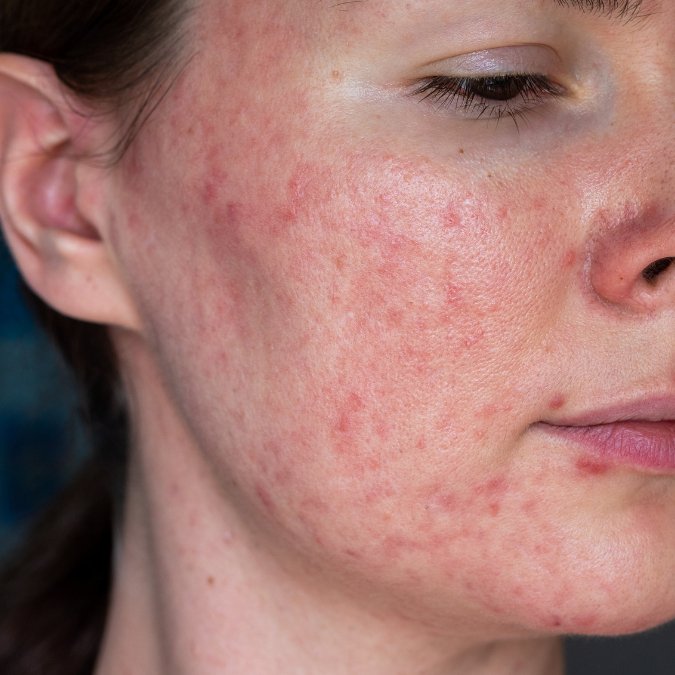Rosacea is a chronic skin condition characterised by redness, flushing, visible blood vessels, and sometimes small, red bumps on the face. Those who suffer from rosacea often seek various treatments to alleviate symptoms and improve their skin's appearance. One such treatment gaining popularity is red light therapy. In this blog, we will delve into the science behind red light therapy and its potential effectiveness in managing rosacea and our range of rosacea fighting LED face mask.
What is Red Light Therapy?
Red light therapy utilises low-intensity red (630-633nm) light to stimulate cellular activity in the skin and underlying tissues. The light energy penetrates the skin without causing damage and interacts with the cells, promoting various beneficial effects. The primary goal of red light therapy is to accelerate natural healing processes, reduce inflammation, and boost collagen production, leading to improved skin health and appearance.
Rosacea: Causes and Symptoms
Before exploring red light therapy's efficacy for rosacea, it's essential to understand the underlying causes and symptoms of the condition. While the exact cause of rosacea remains unknown, several factors contribute to its development, including genetics, environmental triggers, and an overactive immune response. Common symptoms of rosacea include:
-
Facial redness and flushing: Persistent redness and frequent flushing are hallmark symptoms of rosacea.
-
Visible blood vessels: Small, visible blood vessels, known as telangiectasia, may appear on the face, particularly on the cheeks and nose.
-
Papules and pustules: Some individuals with rosacea may experience small red bumps that resemble acne.
-
Eye irritation: Ocular rosacea can cause red, dry, and itchy eyes.
-
Thickening of the skin: Over time, the skin affected by rosacea may become thicker, especially around the nose.
Red Light Therapy and Rosacea: The Scientific Evidence
- Anti-Inflammatory Effects:
Inflammation plays a crucial role in rosacea, leading to facial redness and skin sensitivity. Research has shown that red light therapy has anti-inflammatory properties, which may help reduce the inflammation associated with rosacea (1). By modulating cytokines and cellular signalling pathways, red light therapy can down-regulate pro-inflammatory mediators and promote a more balanced inflammatory response.
One study published in Photomedicine and Laser Surgery demonstrated that individuals with rosacea who underwent red light therapy experienced a significant reduction in facial redness and improvement in skin texture (2). These findings suggest that red light therapy's anti-inflammatory effects could play a vital role in managing rosacea symptoms.
- Improved Blood Circulation:
Rosacea is characterised by dilated blood vessels, contributing to the persistent redness and flushing. Red light therapy has been shown to improve blood circulation, promoting vasodilation and enhancing oxygen and nutrient delivery to the skin. This enhanced blood flow may help regulate blood vessel function and potentially reduce facial flushing in individuals with rosacea.
A study published in the Journal of Investigative Dermatology found that photobiomodulation, another term for light therapy, increased blood flow and microcirculation in the skin (3). While this research did not focus specifically on rosacea patients, improved blood circulation could have positive implications for managing rosacea symptoms.
- Collagen Production and Skin Repair:
Red light therapy is known to stimulate fibroblasts, the cells responsible for collagen synthesis. Increased collagen production helps improve skin elasticity, texture, and firmness. For individuals with rosacea, this could be particularly beneficial in addressing skin damage caused by chronic inflammation.
A study published in Lasers in Surgery and Medicine showed that red light therapy promoted collagen production and improved the skin's healing capabilities (4). Although this study was not specific to rosacea, the results indicate the potential for red light therapy to aid in skin repair and rejuvenation.
- Pain and Sensitivity Relief:
Rosacea can be accompanied by discomfort and skin sensitivity. Unlike some other treatments, red light therapy is non-invasive and gentle, making it a suitable option for individuals with sensitive skin. By promoting cellular repair and reducing inflammation, red light therapy may provide relief without causing further irritation.
A study published in Dermatologic Surgery showed that red light therapy was well-tolerated and effective in reducing erythema (redness) and discomfort associated with various skin conditions (5). While the study did not specifically focus on rosacea, the results indicate the potential for red light therapy to offer comfort to individuals experiencing skin sensitivity due to rosacea.
Using Red Light Therapy for Rosacea: A Comprehensive Approach
While the scientific evidence surrounding red light therapy's potential benefits for rosacea is promising, it is essential to approach treatment with a comprehensive approach, including the following considerations:
1. Consultation with a Healthcare Professional:
Individuals with rosacea should always consult a dermatologist or qualified skincare professional. A proper evaluation of the rosacea subtype, severity, and individual skin needs is crucial to determine the most appropriate treatment plan and avoid any potential adverse effects.
2. Combination Therapies:
While red light therapy shows promise, it is not a standalone treatment for rosacea. Combining red light therapy with other therapies, such as topical medications or oral antibiotics, may yield more comprehensive and effective results. A healthcare professional can tailor a treatment plan that incorporates multiple modalities.
3. Home-Use LED Face Masks:
We would suggest incorporating home-use red light therapy devices for convenience
Review our LED Face Masks with Red Light Therapy:
1. LumiDerma Mask - Best Overall Mask and High Performance
2. TriWave LED - Best Lightweight mask
3. IGLOW Mask - Best Budget Mask
4. Illumination Face Mask - Used by professionals
Use any of our LED Face Mask in combination with our Cooling Recovery Peptide Sheet Mask, which works to reduce redness and repair skin with peptide based technology.
4. Lifestyle and Triggers:
Managing rosacea involves identifying and avoiding triggers that worsen symptoms, such as certain foods, alcohol, extreme temperatures, and stress. Adhering to a healthy lifestyle and using gentle skincare products can complement the benefits of red light therapy.
The Importance of Professional Guidance
Red light therapy may hold promise for managing rosacea symptoms, it's crucial for individuals to seek professional advice as well. Every person's skin is unique, and what works for one individual may not work for another. A dermatologist or qualified skincare professional can assess the severity of the rosacea, provide personalised recommendations
References:
- Avci P, Gupta A, Sadasivam M, Vecchio D, Pam Z, Pam N



